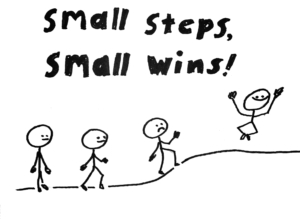Vibrato 1
What is vibrato?
Vibrato is a slight, even fluctuation in pitch. It’s created by rolling the left-hand fingers over the notes.
Why learn vibrato?
Vibrato gives longer notes a rich, singing quality. It’s great on slower tunes like waltzes, not as useful on fast things like jigs, reels and breakdowns.
Who should learn vibrato?
Vibrato can be challenging to learn, so if you’re a beginner, I recommend holding off on the full course. Wait until you’ve learned all the basic finger positions (including low first, fourth and raised third fingerings). However, you can start doing some of the basic hand motions now. That way, when you learn vibrato down the line, your hand will have a head start.
The Vibrato Journey
I’ve made a six-lesson series to help you learn this challenging skill. On each step I’ll be coaching you through the physical, practical and emotional challenges that arise.
In this lesson you’ll get the basic gist of how to learn and practice vibrato.Then we’ll get started with some exercises to train your hand. You’ll also learn a pre-cursor to vibrato: Chromatic Shifting.
Think of learning vibrato as a journey. Instead of seeking instant gratification, learn to enjoy the ride.
This lesson is part of the Ultimate Subscription but is available to all other users for one week after it’s published. Subscribe here. And thanks for your support. 🙏
Preparation for Vibrato
I suggest learning and practicing the chromatic scale and left-hand sliding. If you’re very comfortable with these, it will be easier to learn vibrato. Here are lessons to take or review:
James has an “A-ha moment” with Vibrato
Overview of the Vibrato series
Here’s the learning journey we’ll take. Though it seems like a linear progression, I encourage you to constantly return to simpler, more fundamental exercises. For example, if you’re in lesson 5, I recommend you still practice the basic hand motion without playing.
Note: I wish I could say that learning vibrato happens quickly. If you’re patient, you’ll eventually have your own “A-ha moment”. I’ve created a lot of lessons to help you on this journey. Don’t be intimidated. The first three (including this page) are the most important. Lessons 4-6 are further application.
Essential lessons
- Vibrato 1 (this lesson): Overview, Basic Hand Motion, Chromatic Shifting
- Vibrato 2: Micro-sliding into vibrato
- Though sliding is different than vibrato, it helps you prepare for it.
- “Micro-sliding” is sliding very small distances in a rhythmic pattern.
- Vibrato 3: Slow vibrato pulsing
- We’ll focus on the actual vibrato motion in this lesson: Rolling not sliding
- We’ll start with the first and second fingers (because it’s easier 😀)
Further application
- Vibrato 4: Applying vibrato to 1st & 2nd fingers in tunes
- Vibrato 5: Vibrato on third and fourth fingers
- Vibrato 6: Apply vibrato to 3rd & 4th fingers in tunes
Are you ready to begin your fiddle journey? I’ll send you some free lessons tailored to your current skill level.
Click here to become a FiddleHed!
Learning chunks
I’ve made some “Learning Chunks” to help you learn more easily. These focused exercises contain sheet music, tabs and mp3 snippets to guide you on your Vibrato journey.
Vibrato 1.1

Note: The dots indicate Staccato (stopping the bow). You can decide how pronounced you want to make this. The basic idea is to discretely move the finger from one position to the other. Next, you’ll practice Sliding, which is a continuous motion.
Vibrato 1.2

Variation: alternate between exercise 1.1 and 1.2 (between a discrete shift and a slide) using the same track. I call this a Practice Loop. Generally speaking, practice loops are a great way to practice anything.
Vibrato 1.3

Vibrato 1.4
The remaining tab, sheet music and mp3 snippets are available to paid users. Subscribe here. And thanks for your support. 🙏
Vibrato 1.5
The remaining tab, sheet music and mp3 snippets are available to paid users. Subscribe here. And thanks for your support. 🙏
Vibrato 1.6
The remaining tab, sheet music and mp3 snippets are available to paid users. Subscribe here. And thanks for your support. 🙏
Vibrato 1.7
The remaining tab, sheet music and mp3 snippets are available to paid users. Subscribe here. And thanks for your support. 🙏
Vibrato 1.8
The remaining tab, sheet music and mp3 snippets are available to paid users. Subscribe here. And thanks for your support. 🙏
Vibrato 1.9
The remaining tab, sheet music and mp3 snippets are available to paid users. Subscribe here. And thanks for your support. 🙏
Vibrato 1.10
The remaining tab, sheet music and mp3 snippets are available to paid users. Subscribe here. And thanks for your support. 🙏
Vibrato 1.11
The remaining tab, sheet music and mp3 snippets are available to paid users. Subscribe here. And thanks for your support. 🙏
Vibrato 1.12
The remaining tab, sheet music and mp3 snippets are available to paid users. Subscribe here. And thanks for your support. 🙏
Vibrato 1.13
The remaining tab, sheet music and mp3 snippets are available to paid users. Subscribe here. And thanks for your support. 🙏
Vibrato 1.14
The remaining tab, sheet music and mp3 snippets are available to paid users. Subscribe here. And thanks for your support. 🙏
Vibrato 1.15
The remaining tab, sheet music and mp3 snippets are available to paid users. Subscribe here. And thanks for your support. 🙏
Vibrato 1.16
The remaining tab, sheet music and mp3 snippets are available to paid users. Subscribe here. And thanks for your support. 🙏
Vibrato 1.17
The remaining tab, sheet music and mp3 snippets are available to paid users. Subscribe here. And thanks for your support. 🙏
Vibrato 1.18
The remaining tab, sheet music and mp3 snippets are available to paid users. Subscribe here. And thanks for your support. 🙏
Vibrato 1.19
The remaining tab, sheet music and mp3 snippets are available to paid users. Subscribe here. And thanks for your support. 🙏
Vibrato 1.20
The remaining tab, sheet music and mp3 snippets are available to paid users. Subscribe here. And thanks for your support. 🙏
Vibrato 1.21
The remaining tab, sheet music and mp3 snippets are available to paid users. Subscribe here. And thanks for your support. 🙏
Vibrato 1.22
The remaining tab, sheet music and mp3 snippets are available to paid users. Subscribe here. And thanks for your support. 🙏
Vibrato 1.23
The remaining tab, sheet music and mp3 snippets are available to paid users. Subscribe here. And thanks for your support. 🙏
Vibrato 1.24
The remaining tab, sheet music and mp3 snippets are available to paid users. Subscribe here. And thanks for your support. 🙏
That’s an overwhelming number of exercises!
Sure is. But remember: quality of practice over quantity. I suggest staying with the D2 exercises for awhile, until you can play the in a relaxed manner with joy. 😀
The basic motion: practice without playing
I recommend you practice the basic motion without making any sound. You don’t even need your fiddle for some of these practices. Here’s what I go over in the video lesson:
- Waving to yourself
- Imagine you’re the Queen of England waving to people from a limousine.
- Egg shaker
- This is similar to waving to yourself.
- Rolling in guitar position, not holding fiddle
- Kind of like “air guitar”.
- Train the wrist to relax into this motion.
- Do this anywhere, any time of day!
- Rolling in guitar position, holding fiddle
- Roll the finger from the tip, back to the pad.
- Slowly practice this motion every day.
- Alternate between holding fiddle and not holding fiddle
- Shake out the hand.
- Rolling in Violin position, not holding fiddle
- Notice that the motion is more restricted.
- The Queen’s Wave 👑
- Rolling in Violin position, holding fiddle
- Separate the hand from the neck.
- Alternate between holding fiddle and not holding fiddle
- The Knuckle Twist: Rotate knuckles to pegs.
- Continue to interleave the vibrato practice throughout a session. In fact, you can interleave vibrato practice throughout your entire day if you “Practice without playing.”
Chromatic Shifting
In the exercises above, you’ll practice shifting fingers a half step in a rhythmic pattern. For example, on the D string, you’ll practice shifting fro D2 to DL2. This is a small step towards moving your hand in the vibrato motion.
Take beaks from this to “practice without playing” (see notes above). Or just do something totally different like a tune. Then return to chromatic shifting.
Essential Fiddlosophy for learning vibrato
This is probably the most important part of the whole lesson.
Take the journey. For most folks, learning vibrato takes time. Just prepare for this mentally. And enjoy the ride. Lots of other things will improve as you work through these lessons, like your form, tone, tuning, chromatic scales and sliding.
The whole process will be less frustrating and more interesting with this attitude shift. Plus, it will carry over to everything else you learn and practice.
Consistent practice. More than ever, you’ll need to play every day. But that’s a good thing right? Your hands need time to slowly learn new skills…even when the brain after the brain gets bored. Just commit to working on vibrato for two minutes a day. See The Two-Minute Rule
Interleaving. Simply put, alternate between practicing vibrato and other things within a single session. Studies show that the brain learns better when you repeatedly move between new skills. This is also a form of kindness to yourself. Before you get too frustrated, just switch to something else. Then switch back to vibrato later in the session. Learn more here: Mix Up Your Music Practice With Interleaving
Enjoy the physical sensation of playing. This is an amazing way to make your practice fun and productive. We’ll start with some hand movements. See if you can be fully aware of these motions and take some pleasure in them. This will help you to relax. This powerful practice can transform the way you learn and play because it applies to all physical motion.
Keep returning to simpler steps. In each lesson we’ll layer on a new challenge. This doesn’t mean that you’re done with the earlier steps. In fact, even if you’re doing just fine with each new lesson, I still recommend you return to earlier steps and practice those exercises.

Full sheet music
Sheet music downloads are available to paid users. Subscribe here. And thanks for your support. 🙏
Are you ready to begin your fiddle journey? I’ll send you some free lessons tailored to your current skill level.
Click here to become a FiddleHed!
Return to top of Art of fiddling >>
Leave a Reply
You must be logged in to post a comment.


FYI. Looks like the sound loops for 1.4, 1.5 and 1.6 don’t match the score and are more advanced. Maybe the next lesson?
I don’t think 1.1, 1.2. 1.2 match the sound loops. Any chance they could be fixed?
Gwych. Diolch.
Thank you, thank you, thank you —— I’ve been waiting for this. This is soooo fine !!!!!!!